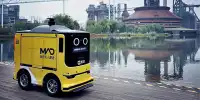For a long time, Google Maps has blurred out the faces of humans owing to privacy concerns – however, as some have noticed, they also blur out the faces of dogs on occasion, providing the dogs some dog privacy. The blurring dog isn’t the first time an animal has been made to seem in witness protection or as a juvenile facing murder charges.
There are a few possibilities for why the animals’ faces were blurred out, including an algorithm mistakenly believing the faces to be human (who knows, maybe the dog and cow had particularly human-like faces, and the algorithm is saving us from that particular horror show) or Google Maps users blurring out their animals’ faces for unknown reasons. “We utilize our algorithms to automatically mask faces and license plates when we compile Street View footage from 360 video recordings supplied by users,” Google writes on their privacy information website.
“We do not apply the blurring technique automatically to non-video footage submitted by users, but they may use the blurring feature in the Street View app to apply blurring to their own images. If your face, license plate, or house appears in a user contribution and you want it deleted, utilize the image’s report a problem function.” Users have the option of having their home obscured if they so want.
Google is committed to protecting our users’ privacy. While we want you to submit content that depicts your reality, it’s vital that you do so in a way that respects other people’s privacy choices. We reserve the right to delete content at our discretion, including in response to user complaints. Continue reading to learn more about how we handle privacy requests for material on Maps and Street View.
We utilize our algorithms to automatically mask faces and license plates while creating Street View material from 360 video recordings uploaded by users. We do not apply the blurring technique automatically to non-video footage submitted by users, but they may use the blurring feature in the Street View app to apply blurring to their own images. If your face, license plate, or house appears in a user contribution and you want it deleted, utilize the image’s report a problem function.
Under no circumstances should you post images or films taken inside private dwellings or from any other publicly inaccessible sites or no-photo zones. Without the owner’s permission, photos and films taken at such private areas should not be made public. Be a nice neighbor and don’t post images or videos of anyone who can be identified without their consent. This is especially crucial in sensitive areas where individuals may object to their photograph being published.
Content containing private or personal information, such as credit card numbers, medical data, or government-issued identification — whether yours or someone else’s — is not permitted. Other than the points specified in this section, any other privacy-related allegations should be submitted using the “Copyright or other legal problems” button on the report a problem feature.
Either Google’s technology obscured the animals’ faces, mistaking them for particularly hairy people, or some users take Fido’s privacy extremely seriously. They should, of course.













